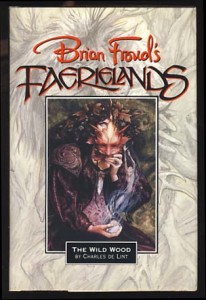 As I was reading The Wild Wood today, I found the imprint of a shape pressed onto the words on the page in front of me. I was puzzled until I turned back one page and saw the same shape, inked in black: one of Brian Froud’s symbolic drawings. I felt then a strange connection to whoever it was who had taken this book out of the library before me, who had traced Froud’s shape for him or herself, pressing hard enough to leave an indentation on the following page. I shared that unknown former reader’s fascination with the shape. Was it a leaf? A feather? A spearhead?
As I was reading The Wild Wood today, I found the imprint of a shape pressed onto the words on the page in front of me. I was puzzled until I turned back one page and saw the same shape, inked in black: one of Brian Froud’s symbolic drawings. I felt then a strange connection to whoever it was who had taken this book out of the library before me, who had traced Froud’s shape for him or herself, pressing hard enough to leave an indentation on the following page. I shared that unknown former reader’s fascination with the shape. Was it a leaf? A feather? A spearhead?
Eithnie is an artist who has lost her sight. No, she’s not blind, but she might as well be. She sees the world around her without seeing it, and paints it without inspiration or passion. There is a shadow over her past, but she refuses to remember the terrible wound that haunts her. Until she looks down one day at a sketch she is halfheartedly rendering and sees, emerging from the trunk and branches of the tree on her paper, faces, the faces of strange magical beings.
It’s a haunting that is peculiarly suited to an artist, to see things in one’s work that one did not put there. But Eithnie’s haunting grows; the creatures in her pictures step out into the world around her, and she begins to see them everywhere in the familiar woods around her home, overwhelming her with the beauty and terror of the unknown. At first she runs away from the faerie creatures peopling her woods. But it is only when she returns and makes the decision to face them bravely and ask what they want of her that she discovers her own power. Mortals who give gifts to Faerie are forever blessed and changed.
Eithnie’s story, The Wild Wood, was brought to life out of an interesting sort of collaboration between another real-life artist, Brian Froud, and a writer, Charles de Lint. Over the course of the summer and autumn of 1991, Brian Froud created over fifty drawings and paintings, inspired by his sense of the evocative magic in the world he saw around him. Then he met with four authors, who went through his pictures of magical, natural creatures, chose the images that spoke most strongly to them, and went off to write whatever story came out of that speaking. When the stories were published, Froud’s pictures accompanied them.
It is perhaps because of this balance, this turn and return between the pictures and the text, that reading The Wild Wood was so unusual for me. I read slowly, stopping often to think, even to put the book down and go away to reflect on what I was reading. I characteristically read any book by de Lint at breakneck speed, eager to find out “what happens!” This time, I looked back and forth between the words and the pictures, noting the similarities between them, puzzling about the differences. The pictures do not illustrate the story; there is no one-to-one correspondence between them. And the differences go beyond such things as “Mabel’s hair is brown in the story, but blonde in the picture.” Instead, it is as if the sections of the story are meditations, narrative musings on the pictures. In this way, de Lint has left openings for each reader to interpret the pictures for him- or herself, adding yet more layers to the story.![]()
The Wild Wood was one of four books that were supposed to come out of the collaboration between Brian Froud and those four writers who met with him. The series was to be entitled Brian Froud’s Faerielands. Of the four, only two were published as part of the series: this one, and Patricia McKillip’s award-winning Something Rich and Strange. A third book intended for the series was The Wood Wife, which Terri Windling wrote, and later expanded and published elsewhere, winning another award. Although Brian Froud’s pictures were not published with The Wood Wife, they can be seen on Windling’s Web site, the Endicott Studio.
(Bantam Books, 1994)
